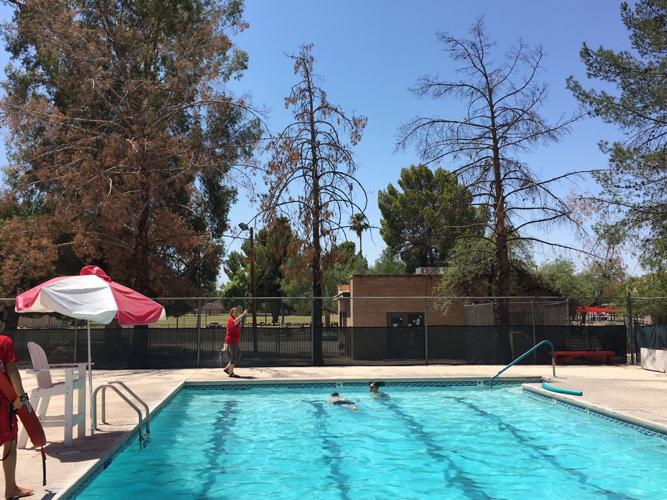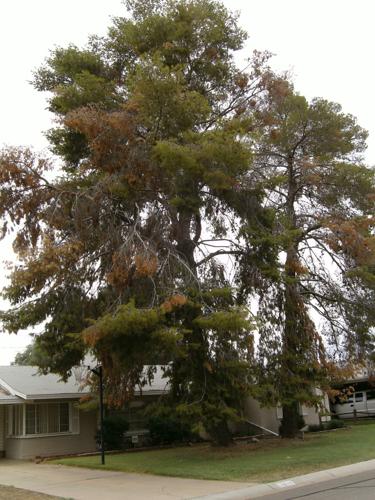On her drives around Tucson, Mary Slachter counts examples of an accelerating infestation.
When she’s able to see the city from above, the big picture becomes clearer.
“It’s really scary for me because if I go up to the Foothills and look down, I can see the death, I can see the browning.”
The browning and death is of Tucson’s trees, especially Aleppo pines. Slachter has kept an informal count of the diseased and dead pines she’s seen around Tucson, a count she said totaled more than 15,000 Tuesday, and remembers the locations of many. She drove me around one small area of midtown Tuesday morning and pointed out dead tree after diseased tree.
Slachter, owner of Quality Tree Service, also gave top-of-her-head estimates for removing trees that in some cases were taller than 60 feet. They ranged well into the thousands of dollars.
It was in 2014 when local arborists first noticed bark beetles killing pines in Tucson. That was a surprise. Previously, scientists had thought the beetles were limited to higher-altitude locations where they feasted on ponderosa pines, not our desert exotics.
Now, four years later, their spread seems to have accelerated. And when a tree dies, it goes fast, often turning brown in a matter of a week or two.
“It boils down to the fact that they’re drought-stressed,” said Tom Ellis, a fellow arborist who is executive director of Tucson Clean and Beautiful.
People planted thousands of Aleppo pines around Tucson from the 1950s to the 1970s, filling neighborhoods like Winterhaven and cemeteries like East Lawn, one of the locations Slachter and I visited Tuesday. At my house, my favorite view is of a massive Aleppo pine about 100 yards away.
The time when they were planted was a different era, climatically and in terms of our local landscaping. These natives of the Mediterranean region thrived in the Sonoran Desert.
“These huge Aleppos, when they were planted and when they grew up to their massive size, were under a completely different regimen as far as irrigation and precipitation,” Ellis said. “They need a lot of water that they’re not getting.”
Imagine an apartment complex where the owners planted Aleppo pines as part of a lush, green landscape back in the 1960s. There was grass, trees and vines. They were watered all the time.
Come forward 50 years, and the pines may still be there, but much of the rest of the property has been turned into xeriscape filled with gravel and native vegetation. Now the owners aren’t watering so much, because they don’t have to. But that leaves the trees dry.
Over the same period, the summer temperatures have gotten hotter, monsoon rains became more spotty, and winter rains less dependable. Together, the conditions have stressed the pines enough to make them welcome hosts for beetles.
“The public, for some reason, will say ‘That’s a mature tree. It doesn’t need any water,’ ” Ellis said. “That’s like saying, ‘You’re an old man, you don’t need any food.’ ”
“We’ve been preaching, pushing and trying to get people to irrigate, but oftentimes by the time people figure it out, the tree is done.”
How much water is required? A slow, deep soaking once a month would be great, across the root zone beneath the tree’s canopy.
Now, it’s worth asking why we should keep these non-native trees alive with our precious, dwindling water. Ellis said his hope is to plant 1 million trees in Tucson during the next 20-30 years. Until then, he said, we need to protect our old ones, especially these venerable shade-casters.
The water is relatively little in the grand scheme, and the loss of shade combined with the cost of removal is a big blow.
As Slachter cruises the rutted alleys of midtown, she’ll tell anyone who crosses her path near a dying tree what they need to do about it. In the corner of McCormick Park, she gave a city worker the lowdown on a pair of eucalyptus trees, one that needed to be taken down, and the other needing some TLC.
While looking at the eucalyptus, she spotted more dead and dying Aleppo pines across the park near the Lighthouse YMCA. There, around the pool, was a cluster of six dead or infested trees, among about 10 that surround and shade the pool.
Slachter gave the unprepared lifeguards in their swim suits detailed instructions for hydration of the remaining trees and getting rid of the dead ones.
Then she added them to her count and drove off to visit and take mental notes of a half-dozen more dead and dying trees.







